I know what you’re thinking! And I don’t blame you!
After my article on Monday about my book dilemma, here I am, writing another book review.
Oh, ye hypocrite! you may well cry. But this is The Thing: This book is so beautifully thorough that I could pretty much eliminate every other book I own on this type of whitework embroidery, thereby saving quite a bit of shelf space!
Of course, I won’t do that. I have several books on whitework that I very much appreciate and use.
But wow! Jenny Adin-Christie’s new book, Fine Whitework, is a barn burner from cover to cover. I think we are super fortunate to have this book available, written by a master embroiderer who has such a profound artistic sense and such notable teaching skills. It seems to me that only Jenny Adin-Christie could have written this book and pulled off such a masterpiece that makes traditional fine whitework accessible to today’s embroiderer.
That’s just my opinion. But let’s look at the book up close. It’s hard to review, because there’s so much valuable content in it. How do I choose what to highlight?!
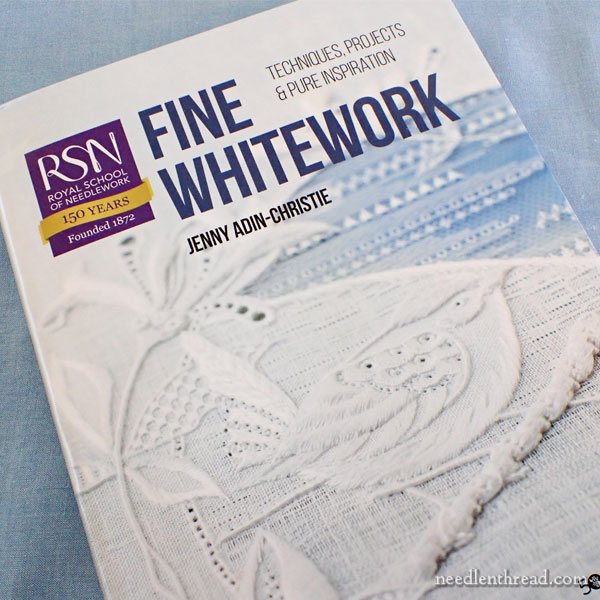
Whitework! It’s a general term. Essentially, it’s an umbrella term for many techniques that have one thing in common: they are worked in white (or neutral) threads on a white (or neutral) ground fabric.
The whitework in this book draws on an array of techniques – from surface embroidery, to needle lace, Desden work, Ayshire whitework, to the various embroidered laces of the nineteenth century… so many needlework traditions! – to bring to life multi-faceted designs through texture and tonal contrast. It’s the texture, the contrast, the multiple layers, the variations in weight and depth, in airiness and heaviness, that enliven this type of fine whitework embroidery and make it so captivatingly beautiful.
The techniques you’ll learn in this book are not restricted to whitework alone, though. They can carry over into innumerable embroidery pursuits.
The fact is, if you’re good at this kind of whitework, the embroidery world is pretty much your proverbial oyster. You can do anything!
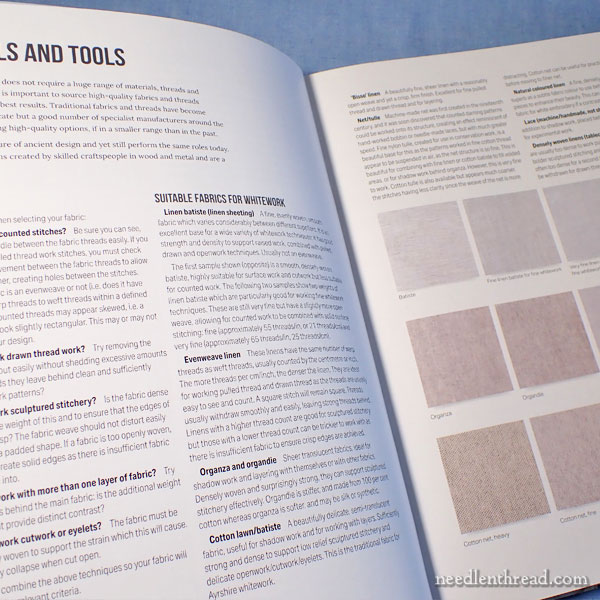
The book begins with an introduction to the Royal School of Needlework, where Jenny found her needlework career, followed by an introduction to and a history of whitework, and then it launches into instruction.
First, Jenny covers materials and tools.
Here’s where you’ll find information on fabrics for fine whitework, with explanations of the different fibers, weaves, weights, and so forth.
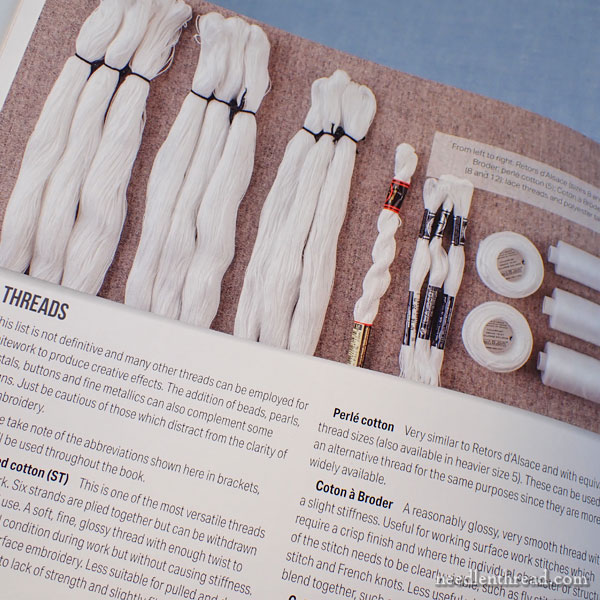
You’ll learn about the threads that are used in traditional whitework.
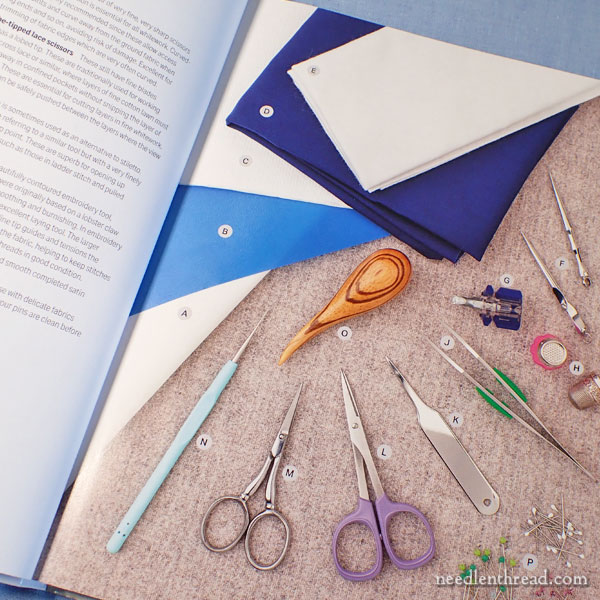
And you’ll explore tools that make the embroiderer’s work possible, easier, or more efficient.
Besides the small tools, Jenny shows us different types of embroidery hoops and frames and how to prepare and use them.
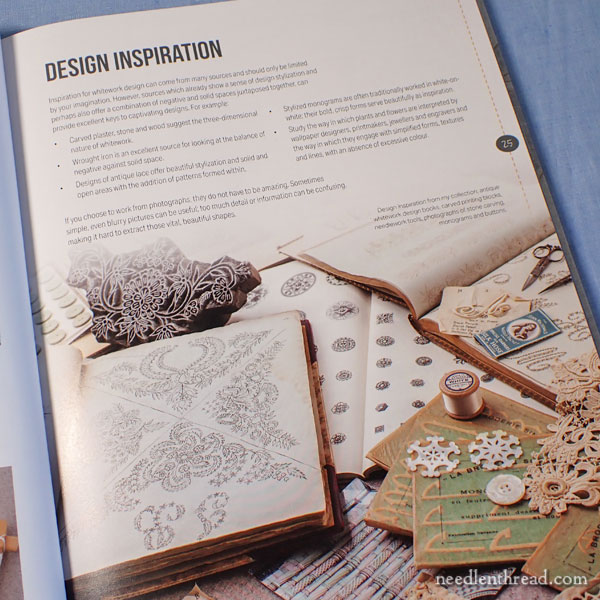
Then, we move along to design inspiration.
The author provides an array of advice on where to look for inspiration and how to consider what you are seeing in the light of whitework.
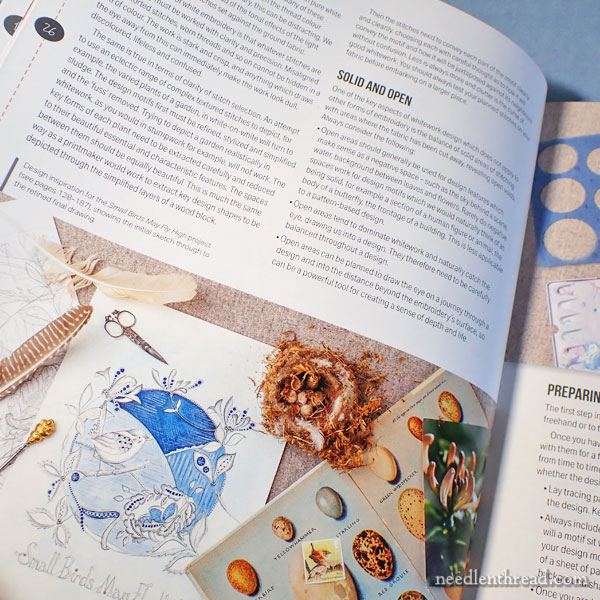
She talks about the difference between solid and open space in designing whitework, teaching us how to consider the open spaces carefully in order to achieve a balanced design that makes sense to the viewer.
Then, she takes us through getting the design down on paper and working it out until we are satisfied with it. Her advice here is invaluable when it comes to the whole concept of designing.
This section is gold.
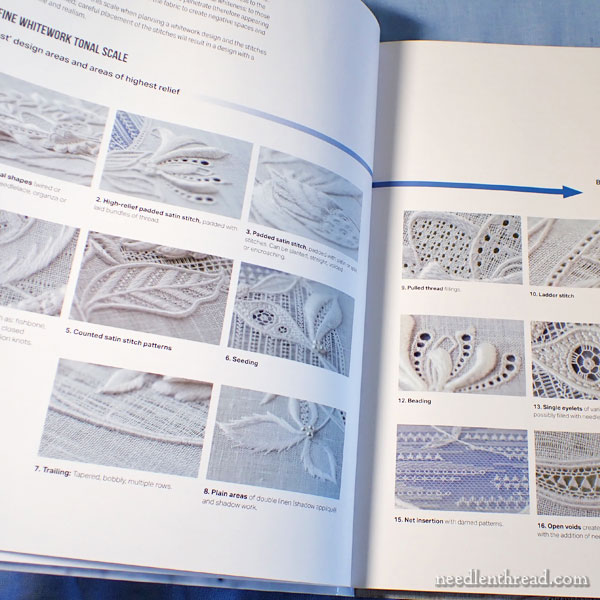
Possibly my favorite pages in the preliminaries: the tonal scale of fine whitework – from the whitest areas to the open, airy areas that become “negative space.”
This section is such a great visual tool for helping the reader to make sense of the way the eye and the mind see and interpret whitework.
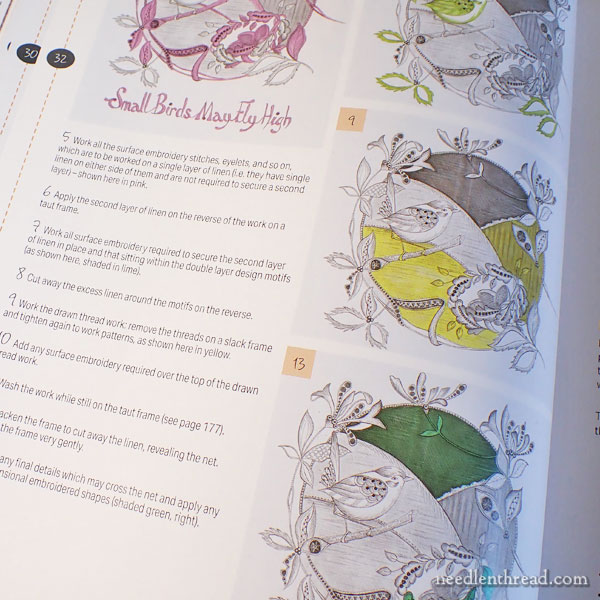
I also love the section on the order of work!
Then, there’s gobs of information on transferring the design in a number of different ways. And there’s a bit on working a preparatory stitch sampler, too, to hone techniques before applying them to your main project.
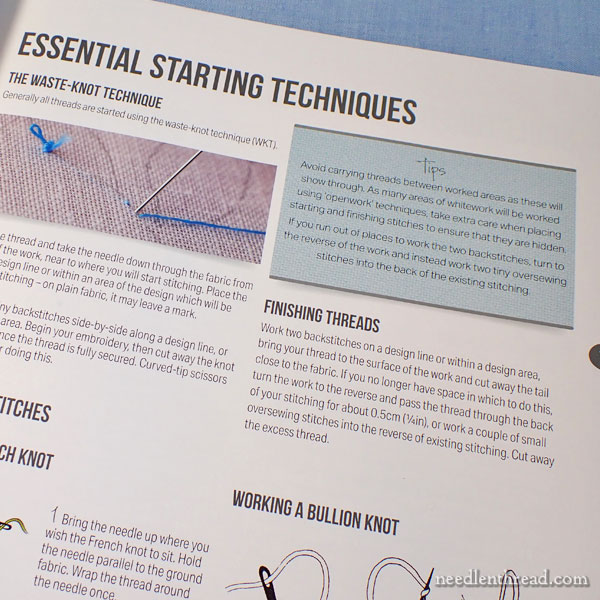
Then, we get into techniques.
This part of the book launches into the detailed instructional content, and it’s divided into six sections: essential starting techniques, sculptured techniques, translucent techniques, filigree techniques, fretted techniques (“fretted” is such a great word), and voided techniques.
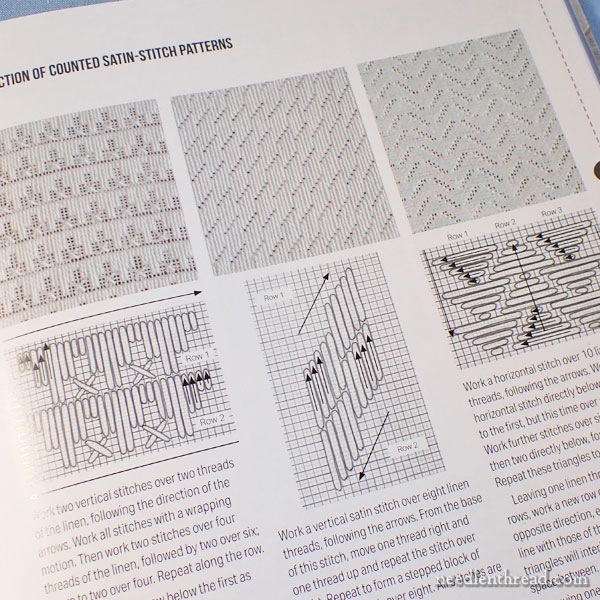
The instructions are offered in easy-to-understand diagrams…
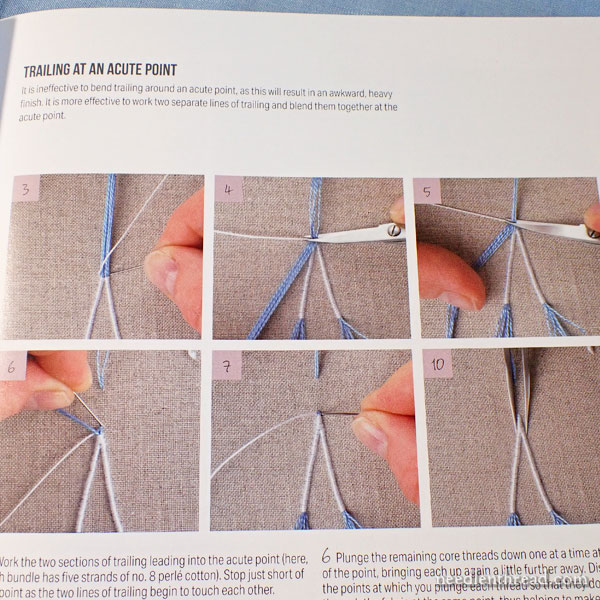
… in step-by-step photos…
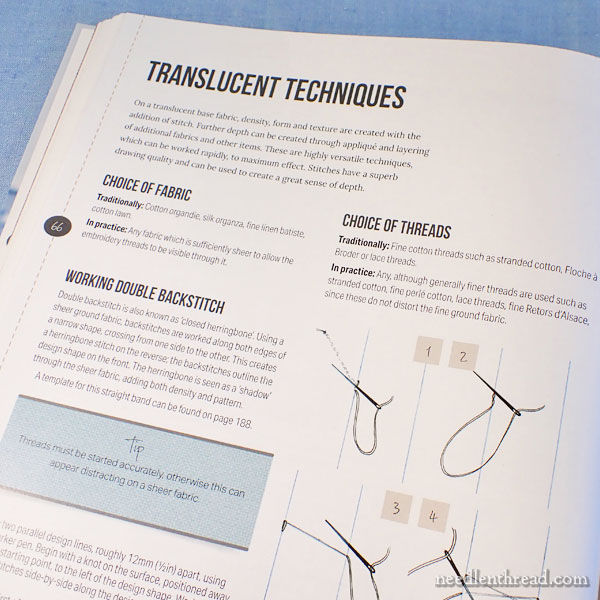
… along with plenty of explanatory text, with helpful tips along the way.
The text is readable and the explanations, diagrams, and photo instructions are all clear, precise, and eminently accessible.
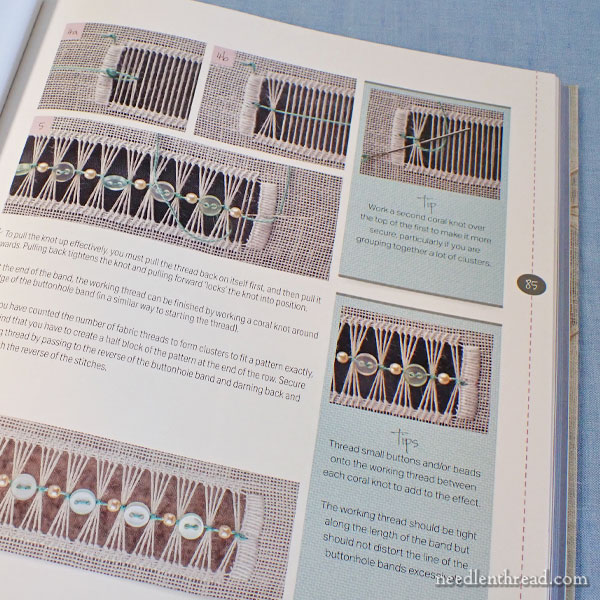
Oh my goodness! There are So Many Techniques in this book!
It’s mind-boggling how much effort must have gone into creating such an organized and clear instructional manual!
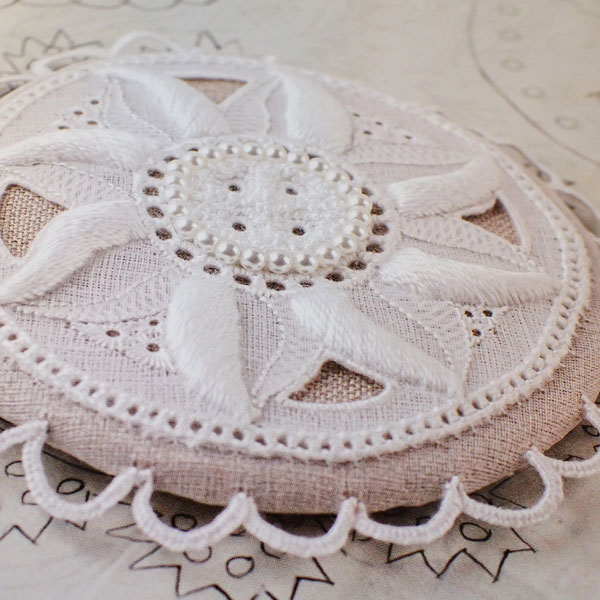
After all the instructional techniques, we are presented with two projects to put our learning into practice.
You might be tempted to say, Only two projects?, but I assure you, the second project is itself a masterclass in fine whitework, incorporating the equivalent of about eight projects when you consider the techniques involved.
Nevertheless, there are two other projects that go along with this book, bringing the total to four projects. I’ll talk about these two extra projects below.
The first project is a small piece with the (sorry, Jenny) unfortunate name of Scabiosa, after the unfortunately-named scabiosa flower. Such pretty flowers, for such a name! (No doubt it comes from the Latin scabiosus, which means itchy.)
But the project is lovely! It is a small roundel incorporating multiple layers and techniques. Think of it as the taster project.
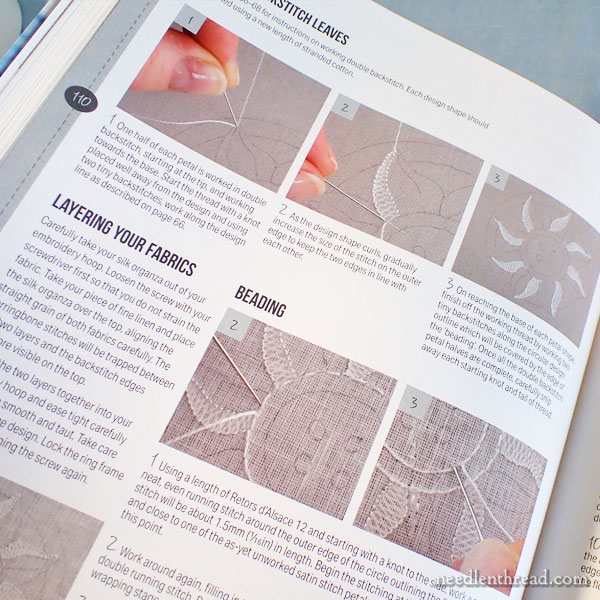
After providing us with materials lists and design, Jenny takes us step-by-step through the project, from beginning to end, in a thorough manner that ensures a successful completion.
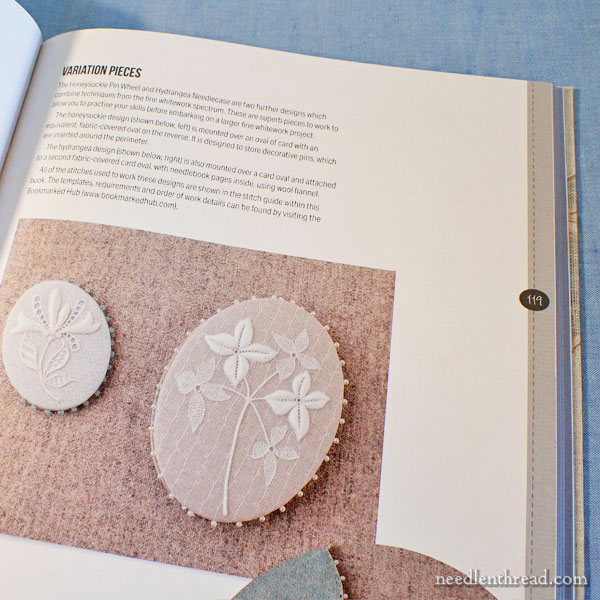
After the project is completed, you’ll find these variation pieces.
Extras Available from Search Press
These are the two designs that will soon be available on Search Press’s “extras” website, Bookmarked. If you’re not familiar with Bookmarked, you might take a look at it. It’s a free-to-join creative books hub, where you can explore titles and extras from your favorite creative authors and designers, in all types of arts and crafts.
Eventually, these two additional projects will be added under Jenny’s profile on Bookmarked, which you can find here. Right now, you can download the templates for the projects in the book, if you want easily-printable templates that you don’t have to photocopy or trace out of the book.
(Warning: Bookmarked can be a rabbit hole… but it’s a fun one!)
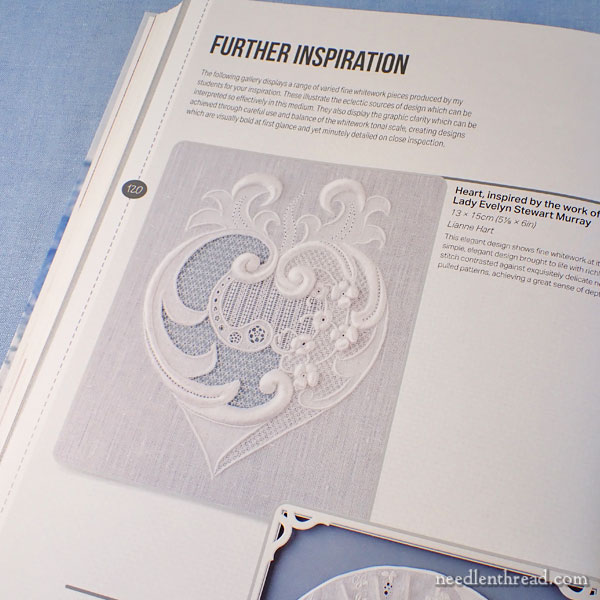
After the first project, we’re presented with a whole section of further inspiration – gorgeous photos of the work of Jenny’s students. It’s a lovely gallery of inventive and beautiful pieces.
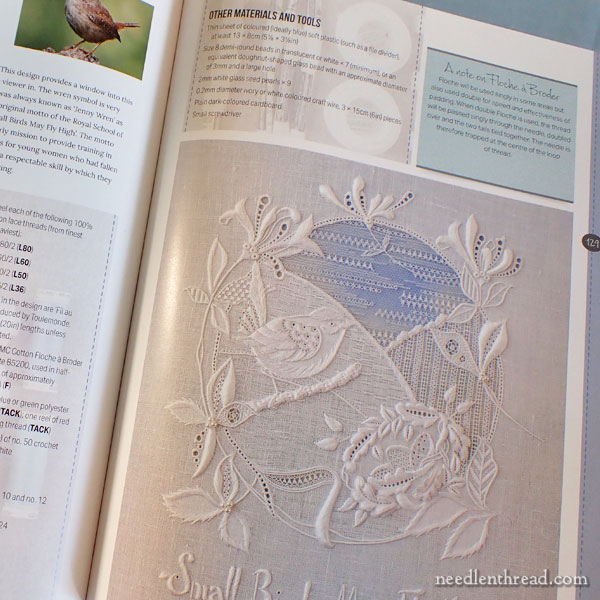
Then, we have the second project in the book, called Small Birds May Fly High – and it’s a stunner.
Again, we are taken step-by-meticulous-step through this project, with over 53 pages of instruction.
It is glorious!!!
There’s no detail not covered here, even to some specialty framing techniques for this type of multi-layered piece.
The book ends with pages of templates for the projects and the technique sampler elements.
In a Nutshell
I really don’t know what else to say about this book, aside from: get it. If you have any interest in this type of embroidery, if it inspires you, if you even just want to learn some of the techniques to apply to different types of embroidery, you’re going to learn well from this book.
Jenny doesn’t leave you guessing on anything – she’s an expert at every level. This comes across in her instruction, which is delivered in an accessible, genuine, and sincere “voice” throughout the book.
It’s a Magnum Opus in every sense of the term. I think it will end up being the standard in whitework instructional books for years to come.
Where to Find It
In the US, Fine Whitework is available for pre-order right now (due around October 18) through Amazon. You can find it listed on my Amazon recommendations page under Browse My Amazon Recommendations.
You can also find it straight through Jenny herself, on her website here. She’s in the UK, so be aware that there is a currency conversion and shipping to consider. However, the British pound is fairly low right now, so if you’re a fan of Jenny’s work, ordering directly from her is a great way to get a signed copy!
Additionally, Jenny will have kits for the projects in the book available on her website “very soon.” The book itself doesn’t launch until around October 18th, so you can probably start looking for kits around that time. She has a couple whitework kits available right now, though. (Or at least, they were this morning!)
The End!
Have a swell Wednesday!
The link to my Amazon recommendations page is an affiliate link, which means Needle ‘n Thread receives a small commission for any purchases made through that link and no extra expense to you. Thanks!







LOL, I just ordered this yesterday!!! It looked amazing and I couldn’t resist, so now I’m feeling even happier- If Mary recommends, it has to be GREAT! 😀
As soon as I saw which book you were reviewing, I skipped to the end and preordered it. I’ll go back and read the article but Jenny has been showing bits and pieces on her Instagram so I knew I wanted it as soon as it was available. And yes, like you, I love books and have so many, there is a stack on the floor in front of a very large set of shelves, plus several stacks on a near by buffet—and still I buy more. There is no hope for people like us. We will continue to buy and collect books. That’s just the way we are.
Oh, there’s always room for one more book! Like that one. Ordered.
You know, I’d really like to see the RSN release a book of those “old” 1920s Training Samplers. Even if they didn’t release patterns, the images would still be an incredible Study Tool!
I can’t wait! this woman’s instructions are extremely valuable!!
Oh, Mary. I think I must have this one. It looks like she covers a technique that I’ve been hunting for the directions for years! And the glimpses you show are so tantalizing.
I first bought the Giant Pink book for my DIL (and then turned around and bought me one; I was so impressed!). To be honest, I bought this because it was so much cheaper than the set of individual books.
I have always wondered about the content of the “smaller” books. I love a good technique book even more than I love stitch bibles! And now, with this (pre-ordered) book on whitework … which has way different content from The Pink Book ….
Are there other individual technique books from the RSN that you recommend over and above their pink book?
Yes, this is not the same book as their RSN essential guide books. I find this book much more thorough! I think the RSN Goldwork Techniques, Projects, and Pure Inspiration book (by Emi Nimura) is good. Also, the Kelley Aldridge one on Raised Embroidery. These books are more thorough than the Essential Guides. The embroidered boxes book is really good, too, if you are into embroidered boxes!
But if I were buying a thorough Goldwork book, I have to admit, I’d go for Alison Cole’s Goldwork Masterclass over the RSN book. Still, all of the above are great for reference!